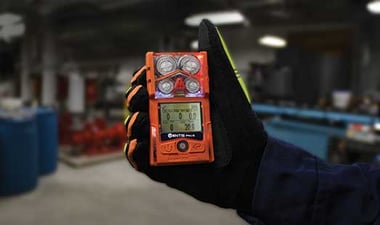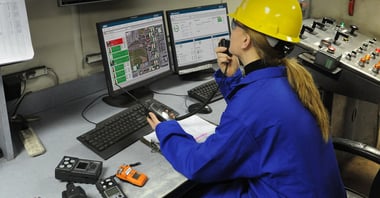 Ammonia gas (NH3) plays a pivotal role in various industrial applications, including chemical manufacturing, food manufacturing, agriculture, and some pharmaceutical manufacturing. Despite its widespread use, ammonia is a hazardous substance that requires careful monitoring to ensure workplace safety and regulatory compliance.
Ammonia gas (NH3) plays a pivotal role in various industrial applications, including chemical manufacturing, food manufacturing, agriculture, and some pharmaceutical manufacturing. Despite its widespread use, ammonia is a hazardous substance that requires careful monitoring to ensure workplace safety and regulatory compliance.
In this blog, we’ll explore the importance of NH3 in industrial environments, potential hazards, best practices for monitoring this hazardous gas, and tips on selecting an effective gas detection system for NH3.
What is Ammonia (NH3) Gas?
NH3 is a colorless gas with a sharp odor. It is commonly used in the production of fertilizers and as a building block for various chemicals. Ammonia is highly soluble in water and can form ammonium hydroxide, which is also used in cleaning products. Despite its utility, ammonia poses significant health risks if not handled properly.
Ammonia Applications by Industry
- Chemical Manufacturing: Ammonia serves as a precursor for producing numerous chemicals, including explosives, plastics, and dyes. It is also used in the synthesis of pharmaceuticals and other industrial chemicals.
- Textile Industry: Ammonia is used in the treatment of cotton and wool to enhance their properties, making fabrics more durable and resistant to shrinkage.
- Agriculture: Ammonia is a key component in fertilizers, providing essential nitrogen to promote plant growth. It is also used in the production of urea and other nitrogenous fertilizers that significantly enhance crop yields.
Hazards of Ammonia (NH3) Gas
While ammonia is indispensable in many industrial processes, it poses several health risks:
- Respiratory Issues: Inhalation of ammonia gas can cause coughing, shortness of breath, and chest pain. Prolonged exposure may lead to chronic respiratory problems, such as bronchitis or pneumonia.
- Skin and Eye Irritation: Ammonia gas can cause severe irritation and burns to the skin and eyes. Direct contact with concentrated ammonia solutions can lead to chemical burns and damage to the cornea.
- Environmental Impact: Ammonia can react with other compounds in the environment, contributing to air and water pollution. It can lead to the formation of fine particulate matter and contribute to the eutrophication of water bodies, adversely affecting aquatic life.
Monitoring Ammonia Levels in Industrial Environments
 Given the risks associated with NH3 gas, it’s crucial to implement an effective gas monitoring system and a robust safety program. Typical best practices include:
Given the risks associated with NH3 gas, it’s crucial to implement an effective gas monitoring system and a robust safety program. Typical best practices include:
- Gas Detectors with NH3 Sensors: Utilize personal and area gas monitors, such as the Ventis Pro5 and Radius BZ1 respectively, with peer-to-peer communications to continuously monitor NH3 levels. Ensure they are calibrated regularly for accurate readings.
- Regular Inspections: Conduct routine inspections of storage and handling areas to detect leaks or other potential hazards. The Radius BZ1 Area Monitor can also be placed for continuous monitoring in these locations.
- Employee Training: Educate employees on the dangers of ammonia gas, proper handling procedures, and emergency response protocols. Practice these protocols frequently to ensure preparedness.
- Ventilation Systems: Implement robust ventilation systems to prevent the accumulation of ammonia gas in confined spaces. Plus, area monitors like the Radius BZ1 are compatible with Modbus and relay control so you can connect your gas detection system to your ventilation systems for automated response.
- Emergency Response Plan: Develop and maintain a comprehensive emergency response plan to address potential ammonia gas leaks or spills. Conduct regular drills to ensure all employees are familiar with the procedures.
Tips on Choosing an Effective NH3 Gas Detection System
Selecting the right NH3 gas detection system is crucial for ensuring workplace safety. Consider the following tips when choosing a detection system:
- Sensitivity and Accuracy: Choose a detector that can accurately measure low levels of ammonia gas, as even small concentrations can be hazardous. Look for sensors that provide stable readings and can differentiate NH3 from other gases.
- Response Time: Look for a system with a fast response time to quickly identify and address leaks or high ammonia levels. Ensure that the alarms are loud and visible enough to alert workers immediately, even in noisy and busy industrial settings.
- Durability and Reliability: Ensure the detection system is robust and reliable, particularly if it is used in harsh industrial environments. Check for IP ratings and other certifications that indicate resistance to dust, water, and other environmental factors.
- Ease of Use and Maintenance: Select a system that is user-friendly and requires minimal maintenance. Regular calibration should be straightforward to ensure ongoing accuracy. Systems compatible with automated docking stations, like the DSX Docking Station, can simplify this process.
- Compliance with Regulations: Verify that the detection system complies with relevant industry standards and safety regulations. Ensure that it meets or exceeds OSHA and other regulatory body requirements.
- Integration with Safety Systems: Consider detectors that can integrate with your existing safety systems, such as alarms and ventilation controls, for a comprehensive safety solution.
Training and Awareness
Even with the best NH3 gas monitors, they aren't effective unless workers know how to use them properly. Regular training sessions should be held to ensure that all personnel are familiar with the operation, maintenance, and response procedures associated with any NH3 gas detection system. Workers should also be educated on the potential sources and properties of ammonia gas to foster a culture of safety and awareness. Some potential safety protocols to train users on include:
- Conducting Risk Assessments: Teach workers how to conduct risk assessments for NH3 exposure to identify and mitigate potential hazards.
- Implementing Engineering Controls: Train employees on how to implement engineering controls to minimize NH3 release and exposure, such as proper sealing of containers and using appropriate ventilation systems.
- Ensuring Proper Ventilation: Educate workers on the importance of proper ventilation in areas where ammonia gas may be present. Emphasize the role of exhaust fans and air exchange systems in maintaining safe air quality.
- Using Personal Protective Equipment (PPE): Provide training on the correct use of PPE, including respirators, gloves, and protective clothing, to protect against ammonia exposure. Ensure that PPE is readily available and in good condition.
- Recognizing and Responding to NH3 Exposure: Ensure that workers know how to recognize the signs of NH3 exposure, such as a strong odor or irritation of the eyes and throat, and the appropriate response actions to a comprehensive emergency response plan – including immediate evacuation procedures, first aid measures, communication protocols, and regular drills.
Regular Maintenance and Calibration
It's vital that NH3 detection equipment is regularly maintained and calibrated according to the manufacturer's specifications. Sensor sensitivity can degrade over time, potentially leading to false readings or a failure to detect the gas. Calibration with known concentrations of NH3 ensures that the sensors provide accurate readings when it matters most. Automated docking stations like the DSX Docking Station can simplify maintenance tasks, ensuring that monitors are always ready for use.
Conclusion
NH3 gas is an essential component in many industrial processes, but its hazardous nature necessitates vigilant monitoring, and safety measures. By understanding the properties and risks of NH3, implementing effective monitoring practices, and ensuring thorough training and awareness, industries can ensure the safety of their workers and the surrounding environment.
Click here for more information on safety and gas monitoring solutions, and to ensure your workplace remains a safe environment for all.



